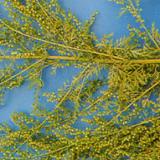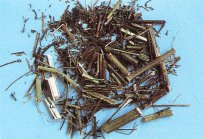Sweet Wormwood
http://www.100md.com
《e Natural Health Center》
 |
 |
 |
 |
Heat Clearing Herbs to Clear Heat of the Deficiency Type
Sweet Wormwood
Latin:
Herba Artemisiae
Origin:
The whole herb of Artemisia annua L. (sweet wormwood) or Artemisia apiacea Hance (celery wormwood), an annual herb, of the family Compositae.
, http://www.100md.com
Wormwood, bitter or aromatic, is an herb or shrub that is distributed throughout many parts of the world. These plants have many small, greenish yellow flower heads grouped in clusters. The leaves are usually divided and alternate along the stem; they may be green, grayish green, or silvery white.
The plant grows to 3 m by 1 m at a fast rate. It is in flower from August to September. The scented flowers are hermaphrodite (have both male and female organs) and are pollinated by insects. The plant requires well-drained soil and can grow in nutritionally poor soil. It can grow in semi-shade (light woodland) or no shade.
, http://www.100md.com
The leaves of the common wormwood (A. absinthium), probably the best-known species, have been used in medicines and such beverages as absinthe. Common wormwood is native to Europe but has become naturalized in Canada and the United States. The leaves of the tarragon (A. dracunculus), another well-known species, are employed as a seasoning, and those of the mugwort (A. vulgaris) are often used to flavour beverages.
A. annua, or A. apiacea, the herb of this page, is grown in southeast Europe and west Asia. It is widely distributed everywhere in China. Reaped in summer and autumn, the herb is used when fresh or dried in the shade, cut into sections and included in preparations.
, http://www.100md.com
Also known as Sweet Sagewort.
Properties:
Bitter and pungent in flavor, cold in nature, it is related to the liver, gall-bladder and kidney channels.
Functions:
Alleviates fever of the deficiency type, relieves hectic fever, removes summer-heat and prevents attacks of malaria.
Applications:
, http://www.100md.com
1. To treat impairment of yin by pathogen-warmth and night fever with morning chills:
Use it with turtle shell, windweed rhizome (Rhizoma Anemarrhenae), tree peony root-bark, etc., e.g., Qinghao Biejia Tang.
2. To treat fever due to yin deficiency and consumptive or hectic fever:
Use it with starwort root (Radix Stellariae), picrorhiza rhizome, windweed rhizome (Rhizoma Anemarrhenae), turtle shell, etc., e.g., Qinggu San.
, 百拇医药
3. To treat fever and headache with thirst due to affection by summer pathogenic factors:
Use it with weeping forsythia fruit (Fructus Forsythia), tuckahoe (Poria cocos), talcum, rice-paper plant stem pith (Medulla Tetrapanacis), etc.
4. To treat malarial chills and fever:
A larger dose of the fresh herb can be blended alone into juice for drinking or the herb can be used in combination with cassia bark, skullcap root (Radix Scutellariae), talcum, indigo, etc., in accordance with the symptoms.
, 百拇医药
Dosage and Administration:
3-10 g.
Decoct the herb and the other ingredients for drinking. It is not recommended that this herb be decocted for a long time. It can also be blended into juice for use when fresh.
Cautions on Use:
It should be avoided by those deficient in spleen-yang or suffering from diarrhea due to asthenia of the large intestine.
, http://www.100md.com
Skin contact with the plant can cause dermatitis or other allergic reactions in some people.
Reference Materials:
'The Compendium of Materia Medica' :
"To treat malarial chills and fever."
'Newly-Compiled Materia Medica' :
"Reducing summer heat."
'The Summary of Medical Works' :
, 百拇医药
"Treating jaundice and ailments due to stagnated fire by clearing damp-heat away from the blood."
Toxic or Side Effects:
Modern Researches:
The herb contains a volatile oil and other ingredients. Both sweet wormwood (Artemisia annua) and celery wormwood (Artemisia apiacea) contain artemisinin, an antimalarial ingredient. As reported in 'Plants for the Future,' clinical trials have shown it to be 90% effective and more successful than standard drugs. In a trial of 2,000 patients, all were cured of the disease.
, http://www.100md.com
Both the raw herb and arteannuin can inhibit the development of plasmodia so as to kill them directly. They also have certain antihypertensive, antipyretic and dermatomyce-inhibitory effects. The volatile oil has antitussive, expectorant and antiasthmatic effects.
The seeds are used in the treatment of flatulence, indigestion and night sweats.
The plant is used in China as a medium for growing Aspergillus which is used in brewing wine.
, 百拇医药
The substances mentioned above in the medicinal uses, used in the treatment of malaria, also show marked herbicidal activity.
The plant yields 0.3% essential oil. This has an agreeable, refreshing and slightly balsamic odour and has been used in perfumery.
The Japanese wormwood (Artemisia japonica) of the same genus is also used in the same way as sweet wormwood or celery wormwood in some areas of China, with similar effects., http://www.100md.com